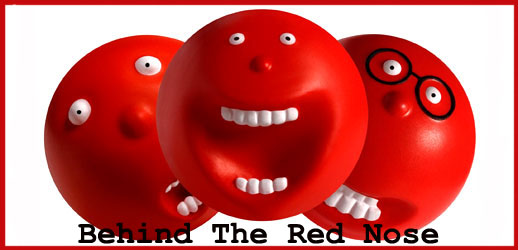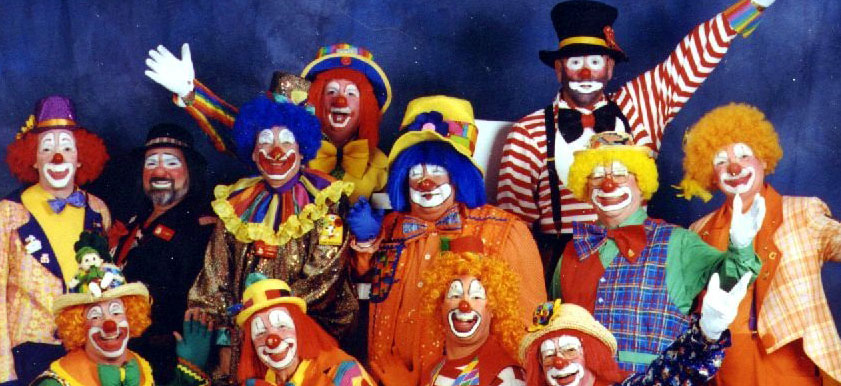Behind the Red Nose (Part Two): Fear vs. Frivolity
“There is nothing laughable about a clown in the moonlight.”
-Lon Chaney Sr.
Clowns. The cultural love-hate relationship with these capricious tramps has been recorded almost to the dawn of the written word, as we discussed yesterday. Yet that relationship had a breaking point; a moment when the pengalum swung like a noose, and a nation nearly rose up with red noses on pitchforks. That year was 1980. “Clown phobia had reached a peak,” a prominent introduction to coulrophobia article said. “Rumors of ritual abuse of children were rampant, and clowns figured heavily into many of the stories. Spontaneous reports of clown harassment began pouring in from children nationwide.”
The tinder for this wildfire of anti-clown sentiment was bundled, set and sparked by three clowns. An unholy trinity which continue to tarnish the art of clowning to this day; Weary Willy, Pogo and Pennywise.
The Clown Who Ate Three Men
 “The modern circus clown is an outgrowth of the tramp clowns of the Depression era. Tramp clowns were largely members of the ‘unsavory’ underclass who entertained the more privileged with a caricaturized look at their daily existence,” according to Durwin, who also wrote that the overwhelming majority of Tramp clowns were—and are—harmless and fun. However, the king of the Tramps, Weary Willie, is another story.
“The modern circus clown is an outgrowth of the tramp clowns of the Depression era. Tramp clowns were largely members of the ‘unsavory’ underclass who entertained the more privileged with a caricaturized look at their daily existence,” according to Durwin, who also wrote that the overwhelming majority of Tramp clowns were—and are—harmless and fun. However, the king of the Tramps, Weary Willie, is another story.
Weary Willie was the clown alter-ego of the legendary Emmett Kelly. Steamboat Joe said that it was his childhood clown friend Happy and his “fascination with Emmett Kelly” which showed him that “being a Tramp clown was my destiny.” Though that destiny has worked out well for Steamboat Joe, that was not the case for Emmett Kelly Senior, Junior or the Third.
Kelly, as Weary Willie, was a clown star. Yet, it seemed Willie wanted the spotlight to himself. Kelly’s personal life grew more chaotic until his wife filed for divorce. Key to that divorce was her claim that “the character had taken over her husband’s personality.” The torch of Weary Willie was eventually passed on Kelly’s son, Emmett Kelly, Jr. Junior was blessed with even more fame than Senior, and sadly, the same fate. His wife also felt that Weary Willie eventually overtook Kelly, Jr.’s personality.
After losing a leg in a train accident, Paul Kelly, the son of Emmett Kelly, Jr., came to the conclusion that he needed to be next in the family business. He changed his name to Emmett Kelly III, the reincarnation of Weary Willie. “Simultaneously, he slid into a life of drugs and sexual freedom. In 1978, Kelly III was arrested for the murders of two of his homosexual partners. He admitted to the slayings, but listed ‘Willie’ as an accomplice.” Later, he was diagnosed with multiple personality disorder.
Everyone Knows Pogo the Clown
Pogo is even more notorious than Weary Willie, but not for his clown face. In this case, the man underneath the red nose was John Wayne Gacy. Gacy, who performed as Pogo the Clown on a volunteer basis, sexually assaulted and murdered over thirty-three young men and boys from 1975 to 1978 while living in Chicago. Gacy, and Pogo the Clown, have been played by Brian Dennehy in To Catch a Killer and William Forsythe in Dear Mr. Gacy which was based upon the book The Last Victim by Jason Moss. The movie Gacy, was released in 2003 with lesser-known Mark Holton in the role of John Gacy.
Gacy is a fine example of media over-sensitization. Though Pogo was such a small part of Gacy’s life, the idea that this killer was also a clown added a chilling dimension to an already demented case. Gacy spent most of his life as owner of PDM Contracting, yet we don’t find any “Killer Contractor” memes in modern culture.
But Wasn’t IT Really a Spider, not a Clown?
“Stephen King’s movie IT, which featured a demented, murderous clown named Penny- Wise, did for clowns what Psycho did for showers and what Jaws did for swimming in the ocean.”
– Michael Goldman, The Toronto Star
Weary Willie and Pogo may have stacked the kindling and poured gasoline on the collective unconscious, Stephen King set the pyre ablaze in 1986 when IT hit the shelves. Later the made-for-TV movie of the same name further shaped our fears. “In the decades that followed,” according to Durwin, “killer clowns have become a part of our human mythos.”
Though all three of our interviewed clowns are frustrated with the IT theory of coulrophobia, Alex the Clown put the finest point on his vexation. “‘I saw the movie IT and it ruined clowns for me,’” he quoted. “What kind of rationalization is that!? I saw the movie Grease and I don’t expect people to jump into song randomly and unexpectedly.”
It is that unexpectedness of clowns, linked to the legacy of the criminal clown, which chills Benjamin Proctor, a twenty-five year old software company director. “They’re social outlaws…it’s as if they’re authorized to do things ordinary people can’t do.” When it came to deviants like Gacy, Kelly III or Penny-Wise, clowning became killing in our cultural minds.
Can’t Sleep, Clowns will Eat Me
“I have to physically leave the room when commercials with that incredibly evil-looking clown hawking Play Station on TV are being aired.”
-Kristine M.
 It’s no secret that in today’s society, evil clowns and the hatred of clowns fuel an industry. No matter if it’s the media “making clowns out to be evil, twisted monsters” to get ratings instead of the “warm hearted people practicing a traditional for of art” which Steamboat Joe believes them to be, or websites like www.IhateClowns.com and www.Clownz.com who provide anti-clown merchandise and links along with forums where coulrophobics can share their fears in a safe environment, the hatred and fear of clowns has a market all its own.
It’s no secret that in today’s society, evil clowns and the hatred of clowns fuel an industry. No matter if it’s the media “making clowns out to be evil, twisted monsters” to get ratings instead of the “warm hearted people practicing a traditional for of art” which Steamboat Joe believes them to be, or websites like www.IhateClowns.com and www.Clownz.com who provide anti-clown merchandise and links along with forums where coulrophobics can share their fears in a safe environment, the hatred and fear of clowns has a market all its own.
A lengthy BBC article from 2008 noted that movies which feature an evil clown are on the rise, including highpoints like “Clownhouse from 1990 where three boys at home alone are menaced by escaped mental patients who have taken on the identities of clowns they have killed and Mr. Jingles from 2006 or 2004’s Fear of Clowns, in which an artist with coulrophobia is stalked by a clown resembling one of her paintings.” For every high, there are countless low points, such as S.I.C.K., Killjoy or the Camp Blood Trilogy. Who could forget the 2001 classic, Killer Klowns from Outer Space? A tagline like “In space no one can eat ice cream” may not be memorable, but the movie itself has garnered a place in pop-culture history.
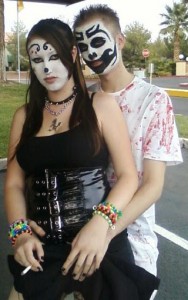 The Juggalo movement has been greatly influenced by the concept of the evil clown since it encompasses all fans of the music of Insane Clown Posse and other Psychopathic Records bands who’s members dress, and often write songs about, evil clowns. Any fan can chose to call themselves “Juggalo” or “Juggalette” and be a follower of the bands. Some go further. Some fans chose to dress up in clown makeup and evil clown gear and consider fellow Juggalos a family, which calls to mind the tribal history recorded by Durwin, Lucille and Willeford. Some fans go one step further and embrace a spiritual element of the Juggalo clown faith, considering the makeup a sacred mask, following a ritualistic mythology and potentially ushering in a modern re-shamanization of the clown.
The Juggalo movement has been greatly influenced by the concept of the evil clown since it encompasses all fans of the music of Insane Clown Posse and other Psychopathic Records bands who’s members dress, and often write songs about, evil clowns. Any fan can chose to call themselves “Juggalo” or “Juggalette” and be a follower of the bands. Some go further. Some fans chose to dress up in clown makeup and evil clown gear and consider fellow Juggalos a family, which calls to mind the tribal history recorded by Durwin, Lucille and Willeford. Some fans go one step further and embrace a spiritual element of the Juggalo clown faith, considering the makeup a sacred mask, following a ritualistic mythology and potentially ushering in a modern re-shamanization of the clown.
Psychologists theorize that the prevalence of the “sinister clown meme” in movies, music and “even children’s books” have caused an over-sensitization of the concept in children which has caused the noted rise coulrophobia. However, both Alex the Clown and Skats share a belief that misrepresentation of the majority is a much simpler answer to the rise of clown fear.
“People who won’t speak to you at all, won’t come close, keep a distance and stay quiet; those are the people I know are afraid for real,” Skats said. But that was the minority, and he justly gave them their distance. The majority of people that Skats has met who fear him, tell him so which seems to be a contradiction. “If they were really afraid of me they wouldn’t be telling me why, they wouldn’t be telling me anything.” Where Skats sees a contradiction, Alex sees a confirmation that most people who say that they fear or hate clowns, really don’t feel either emotion. “I think that people today think it’s hip to be scared of clowns. Because, honestly, a clown isn’t cool. So being scared of clowns, naturally, is the opposite of liking them.”
Did You Say “Clownselor?”
“A clown is like aspirin, only he works twice as fast.”
-Groucho Marx
Despite those who may hate and fear clowns because it is cool to do so, the therapeutic community must address those like Steve who shared with a www.IhateClowns.com forum that his “therapist bills are getting out of hand” processing an incident which happened when he was twelve years old. “I went to this haunted house for Halloween, and this clown-corpse…actually fell on my actual head.” He then “wet [his] best pants” and “screamed the place down.”
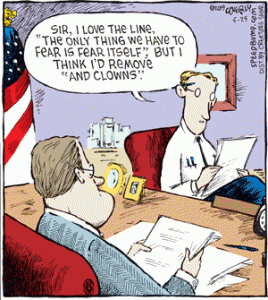 The specific treatment includes classic methods like medications, hypnotherapy, systematic desensitization therapy to face coulrophobia, and various trauma expression techniques. But, depending on the severity of the fear, phobics should choose if they truly desire treatment at all. Most honorable clowns, especially the three interviewed, respect those who are truly fearful and will not interact with them. Thus, as Skats put it, there may be no need to seek therapy “just keep a distance and keep it moving. it’s not like you’ll ever have to sit next to one on an airplane.” Way To Hope, a diverse phobia site, asserts that “unless this phobia is extremely severe,” this technique is “probably a less intrusive approach…particularly for children.”
The specific treatment includes classic methods like medications, hypnotherapy, systematic desensitization therapy to face coulrophobia, and various trauma expression techniques. But, depending on the severity of the fear, phobics should choose if they truly desire treatment at all. Most honorable clowns, especially the three interviewed, respect those who are truly fearful and will not interact with them. Thus, as Skats put it, there may be no need to seek therapy “just keep a distance and keep it moving. it’s not like you’ll ever have to sit next to one on an airplane.” Way To Hope, a diverse phobia site, asserts that “unless this phobia is extremely severe,” this technique is “probably a less intrusive approach…particularly for children.”
John Lawson’s Circus, which is currently touring Britain, has a different method. They call it “clownselling” and it is “aimed at overcoming peoples’ fears associated with its show’s starring duo,” as reported by NewsCore.
The goal of the “clownselling” service is to combat the cause of the anxiety which Pr. Salkovskis of the Maudsley Hospital Centre says “Is almost certainly not a reaction to clowns, but we are sensitive to things which are extraordinary, particularly sensitive when we are young.”
Paul Carpenter, is head “clownselor.” He, his clown partner, and the ringmaster at Lawson’s Circus offer free workshops in which people can “confront their feelings and even access their own ‘inner clown.’” Participants first see clown actors in ordinary clothes, then, on a backstage tour, they can watch the actors gradually transform into their clown alter-egos. As a sort of grand finale and corrective emotional experience rolled into one, participants “are then encouraged to talk about their fears and dress up as clowns themselves, if they want to.”
Steamboat Joe simply encourages any clown to “carry a non-threatening picture of themselves without make-up to show the fearful individual, that a clown is just like them,” while Skats said that the “clownselor” approach is gaining popularity. A growing number of circuses “let the audience come an hour before the show and watch the clowns put on their make-up. One gets to watch the magic of a regular guy or gal turn themselves into a clown right before their eyes.” Further, “some party clowns have started booking this out as a show. You can watch them become a clown and then they put on a show right afterwards. I think this lets people who are fearful see…that clowns are just men or women like themselves who just so happen to also have the ability to transform themselves into a larger than life character who can display talents that entertain.”
Hurts the Clown
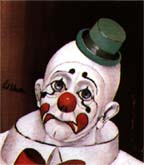 Which brings us to the invisible victim of coulrophobia. Invisible, because he or she is behind the grease paint and the red nose. Durwin notes that during the age of anti-clown “mass hysteria” in the 1980s a man named Gerald Amirault in Malden, MA. “was accused and imprisoned” for dressing as a clown and allegedly molesting children at the daycare his wife ran. “Having studied the relevant information on the case,” Durwin stated, breaking the fourth-wall of his article, “I am of the opinion that Gerald Amirault is a man wrongly accused – another victim of the 1980’s media obsession with [clowns,] satanic cults and ‘ritual abuse’ scandals.”
Which brings us to the invisible victim of coulrophobia. Invisible, because he or she is behind the grease paint and the red nose. Durwin notes that during the age of anti-clown “mass hysteria” in the 1980s a man named Gerald Amirault in Malden, MA. “was accused and imprisoned” for dressing as a clown and allegedly molesting children at the daycare his wife ran. “Having studied the relevant information on the case,” Durwin stated, breaking the fourth-wall of his article, “I am of the opinion that Gerald Amirault is a man wrongly accused – another victim of the 1980’s media obsession with [clowns,] satanic cults and ‘ritual abuse’ scandals.”
Clowns also are the floppy shoed victims of “the widespread hostility” induced by the meme of the evil clown that has become “a cultural phenomenon which transcends just the phobia alone.”
Steamboat Joe puts on his makeup and climbs into his wheelchair with the help of an assistant for the sole opportunity to “make someone smile” with his clown antics. He succeeds, even though “for me due to being disabled, [my act involves] performing without the physicality.” Alex the Clown overcame childhood fear, first of clowns, then in one of his first performances as a clown. A birthday party. “I walked in to find a room full of ex-convicts…some still in orange jumpsuits. There I was, 14 years old, stranded to perform for the scariest audience of my life.” Skats goes to hospitals at Christmas, has performed shows for the Muscular Dystrophy Association camp in Long Island, and worked parties for United States Troops moments before they were sent off over seas. “I’ve been able to help people through rough times simply by given them a memory, some good feelings, a few laughs,” he said. “They were at a moment in life where they could have been focusing something unpleasant I’ve been able to give them something pleasant to focus on. That feels good.”
The heart of a clown is equal parts eternal joker and determined scrapper, but it is still a heart like any other. They see themselves as artists seeking to bring joy in a way that, though unusual, is not twisted in the overwhelming majority of cases. Yet, as a result of genuine phobia or “widespread hostility” clowns can be the target of the exact opposite of the emotion which they are trying to create, and left bewildered by the cause. “I’ll bet he wondered what my problem was!” C. Brown wrote on www.Clownz.com, when, years after the event which rightfully soured her on clowns, “I was at a carnival with some friends and a clown waved and said hello. I shot him the finger.”
A Pie in the Face or a Face in the Moonlight?
There are documented cases of coulrophobia by childhood clown trauma. There are theories that we are either over-sensitized to the “sinister clown meme” and have adopted a legitimate norm of fear, or simply hate because it’s cool to do so. There is the anthropological rationale that clowns are the modern day shamans of chaos and we fear them “because they mock the holes in our conception of the universe, our notions of safety and security, and all the other frail certainties of our time.” There is Durwin’s rational approach, that the “ancient tendency of clowns to fail to recognize established boundaries [led] to the marginalization of clowning in our society, and…the fear of clowns, especially clowns with associations to the supernatural.”
In the end, though every legitimate phobia should be respected, our reaction should be governed most by our context. As silent move star Lon Chaney Sr. said nearly one hundred years ago, “there is nothing laughable about a clown in the moonlight” and if you encounter a clown in such spooky a circumstance, lurking and malevolent, then you are right to run, scream, or shoot him the finger. If you encounter a clown at a circus, a fair or a party, then it is right to keep your distance. But, in that appropriate context, perhaps take a risk. “I would tell them to go up to a clown and give the clown a hug,” Steamboat Joe shared. “Especially, if I am that particular clown.”
________________________
Happy Halloween, one and all! I hope you enjoyed reading this special double-feature as much as I did writing it. Please do drop a line (or some business) on Steamboat Joe, Skats, and Alex the Clown. I am quite grateful to these three fine, kind hearted, grease painted gentlemen. This article would be much less without them.
K

